On wednesday, June 9, I
loaded up the car with all the gear, the
generator, antenna, water and other
supplies. I also assembled the equipment in
the car and tested it all on a dummy load so
I could travel with the equipment already
set up, in order to save time when I arrived
at the site. With the exception of the
antenna, I was using the same
equipment that I take with me on 6m EME
DXpeditions to rare DXCC. That setup is
described in detail here.
Basically, it was a Dell XPS 13 laptop
computer, FT857 transceiver (used as the
transmitter}, 6M1K2 amplifier and an Airspy
R2 SDR receiver with an ARR preamp.
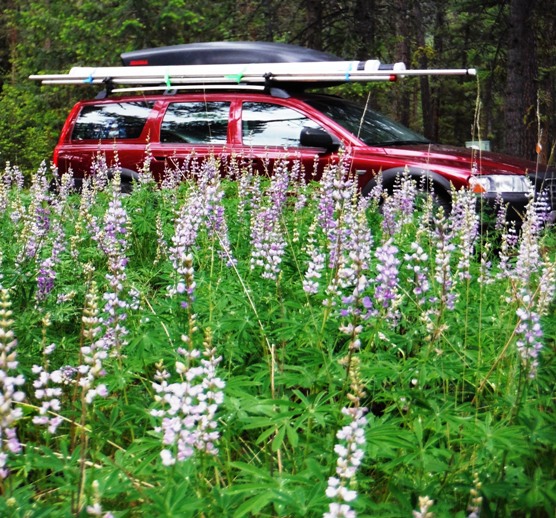
On Thursday, morning June 10, I drove over the
Continental Divide to eastern Montana. I arrived
in Dupuyer, MT in time to check out the roads up
on the Theodore Roosevelt Memorial Ranch,
including the one to the planned operating site.
I had already obtained permission from the ranch
manager to set up and operate for several days
in that high remote corner of the ranch. The
weather was clear and the roads were not too
muddy to drive on, which was reassuring. I then
returned to Dupuyer and checked into Buffalo
Joe's motel for the night.
At dawn on Friday June 11, I headed up to the
site. I drove in a ground rod and set up
the generator 50' west of the car and put up the
6M5XHG antenna at 5300' on a 24' mast 20' east
of the car in order to provide maximum
separation between the two, and also to avoid
needing to aim the antenna at either the car or
the generator. I use 50' of heavy extension cord
to carry 220 VAC from the generator to the
station set up in the car, and 50' of LMR-600 UF
low loss feedline to run from the antenna to the
car.
The 6m band was open by the time I got set up. I
slept in the back of the car just to be safe,
but fortunately I had no grizzly bear
encounters! I operated until 0200Z on Monday
June 14, when an approaching thunderstorm made
me shut down, lower the antenna and mast, and
disconnect everything from the equipment in the
car. The storm hit at 0300Z with lightning and
tremendous winds. There was a bright double
rainbow as the storm approached because it also
was hitting right at sunset. The car was
buffeted around but everything remained intact.
There was some severe storm damage and
power outages in the towns south of me.
e 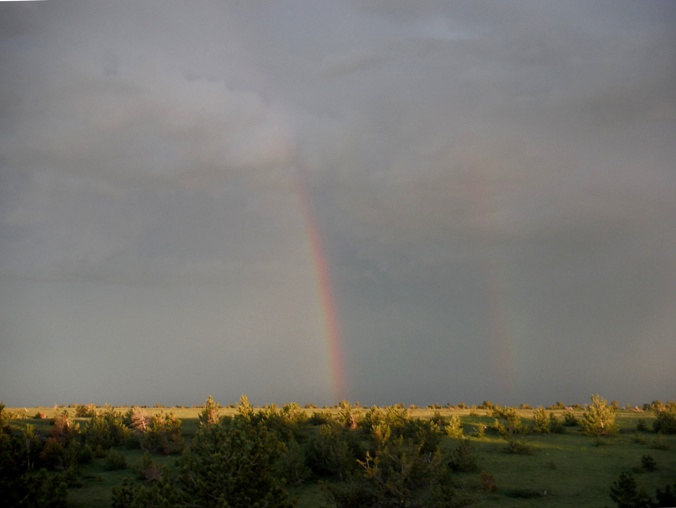
I started packing up at dawn on Monday and
by 10 am was on the road home. I didn't get
reliable cell phone service until around 11
am. All in all, it was a beautiful place,
although sleeping and operating in the car
for that long was tough on these old bones!
I hope this lessons the immediate demand for
DN38, for awhile at least!
|
Station setup looking to
the northeast out over the plains.
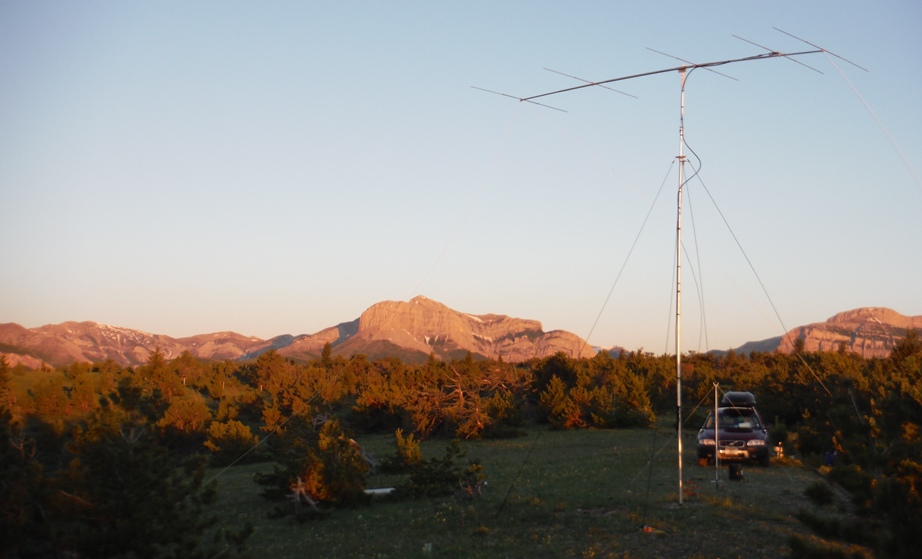 View to the west toward the Rocky Mountain
Front.
View to the west toward the Rocky Mountain
Front.
|
|
|
|
June 27-30,
2021
DN34gx above
Lemhi Pass and the Continental Divide in
Lemhi County, ID
at 7550'
|
Horizon
Profile from DN34gx site
 The highest point on the horizon is below 5
degrees, and the horizon is under 1 degree (or
less) to most the continental USA requiring
double hop Es.
The highest point on the horizon is below 5
degrees, and the horizon is under 1 degree (or
less) to most the continental USA requiring
double hop Es.
|
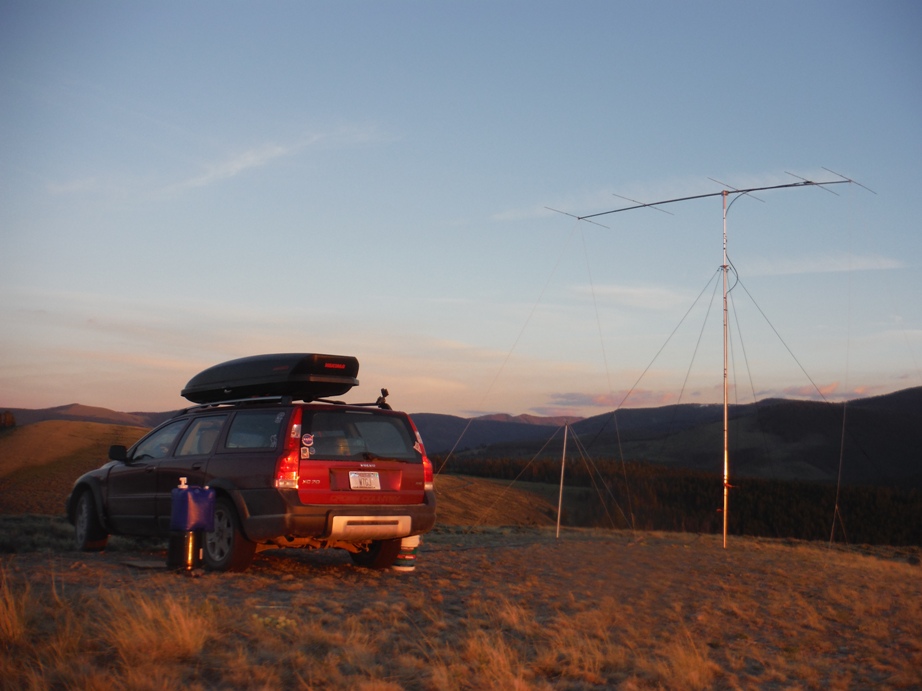
6M5XHG installed on top of hill southwest
of Lemhi Pass overlooking the Continental
Divide
On Sunday, June 27, I drove
down to the same site I activated during Field
Day in 2015. Additional photos of the site can
be found on the summary of the 2016
DXpedition. The weather looked
good for an extended operation in the mountain
- clear, although unusually hot. The 7550'site
in Lemhi County, ID, is on a hilltop just
outside the national monument area, and looks
down on Lemhi Pass and the Continental Divide.
Because the location is in national forest
land, "dispersed camping" is permitted, which
is ideal for an extended grid activation. The
location is shown by the red asterisk on the
map to the right.
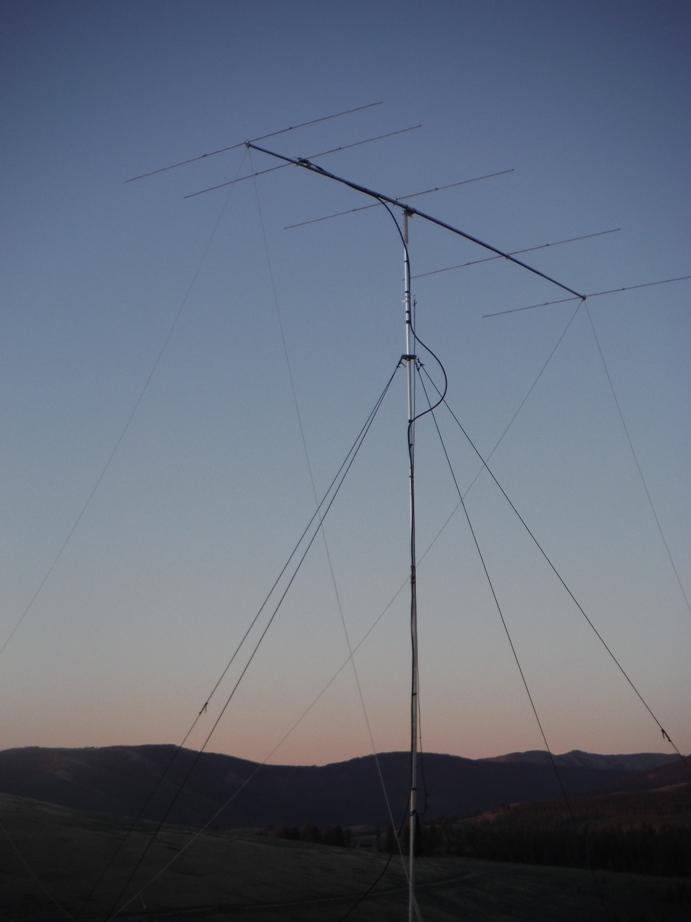
The band was open to W1 when I first got on
the air Sunday afternoon, and was open for 14
hours on Monday June 28, again including many
double hop stations and 4 triple hop stations
in KP4. The biggest activity on Tuesday June
29 was toward Asia, and I logged 37 contacts
in Japan as well as BA7IO, BX4HG, and BG6CJR.
Just as I was starting to again begin getting
double hop signals from Florida (and a much
longer multihop sequence from 9Y4D), I finally
had to stop finally operating at 1830Z
Wednesday. I then spent the next several hours
out in the 90+F temperatures dismantling the
antenna and packing up to head home. The most
challenging chore was trying to extract the
ground rod by the generator, which I had very
successfully pounded into the rocky
soil. and start packing up to head
home.I shut down at 1830Z Wednesday and
started packing up to head home. I finally
made it home at 9 pm, just as the sun was
setting.
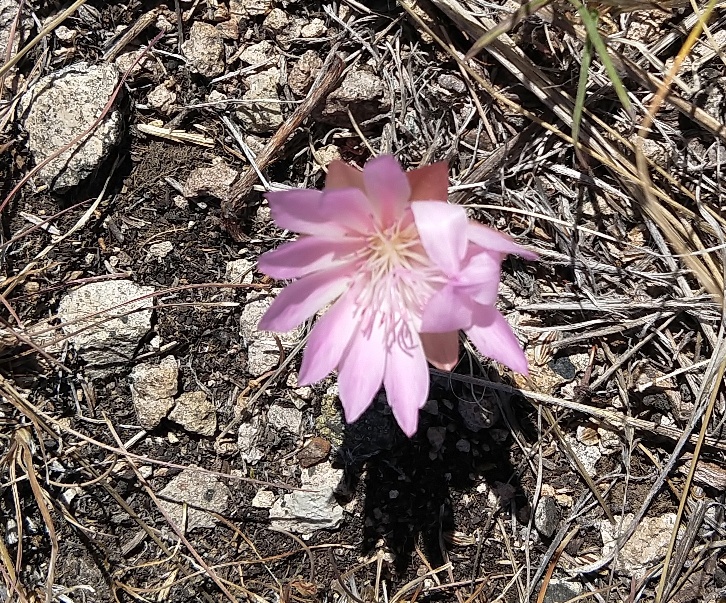
Contrary to the experience there in 2016, when
there were Bitterroot flowers everywhere, this
was the only one left this time. All the other
Bitterroot plants had lost their flowers,
probably due to the hot, dry weather compared
to 5 years ago.
|
At the time of this trip, I was having some
problems with my FT857 output being reliable
enough to drive my 6M1K2 amplifier. I therefore
has to rig up a more complicated concoction of
gear and squeeze it into the car, while still
leaving enough space for me to sleep in the back
of the car if I chose not to take time to set up
the tent. In the view from the driver seat
below, you can see the laptop computer.
The RIGblaster Nomic was resting underneath it
on the console between the front seats. Below
the wattmeter, you can see the blower sitting on
the TE Systems amp and blowing air out the amp's
cooling fins directly onto the cooling fins of
the KX3, which provided about 2.5 watts on FT8
into the TE Systems amp.
Below is the view oft the passenger seating
area from the open door. Styrofoam spacers
are seen positioning the fan on top of the
TE SYSTEMS driver amplifier.Aluminum channel
spacers were used to maiintain ventilation
space around the sides of the amp. To the
right of the TE Systems amp was the
Powerwerx 12 VDC power supply for the KX3.
The preamp was powered by a battery that was
being charged whenever the generator was
running. Under the glove compartment,
sitting on a plastic crate, was a 12VDC high
current switching power supply to power
the amp. Not visible is the ARR
preamp, 6m bandpass filter and Airspy R2
receiver that fed into SDR Console software
via a USB cable for the separate receiver.
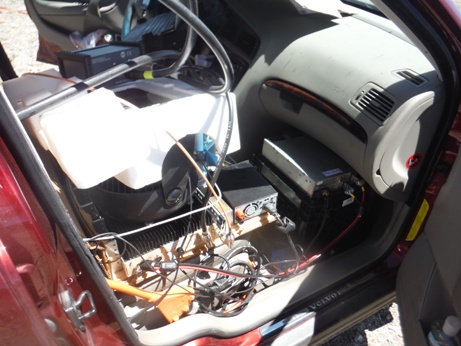
Behind the passenger seat was a table I made
from a surplus piece of countertop. The
6M1K2 amp sat on top, with its Meanwell
RSP-3000-48 power supply sitting below it.
Another fan between the cooler and the
amplifier insured good air circulation for
both the amp and its power supply. Not a
very neat and tidy setup, but it was OK for
what it was doing ;-)
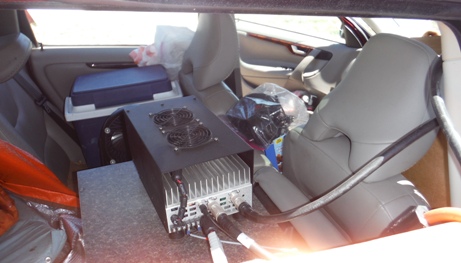
Thanks for all the fun and
all the contacts, especially those for whom
DN34 was still a needed grid! I hope this
has knocked DN34 further down the FFMA "most
needed" list!
I couldn't leave Lemhi Pass
without swinging by the Sacajawea Memorial
Area and the spring that feeds the tributary
that caused Lewis and Clark to make their
way to Lemhi Pass from the Missouri River.
Those photos are shown below.
|
|
This page last
revised on 4 July, 2021

|